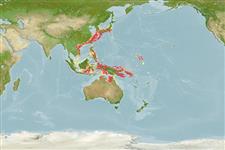>
Eupercaria/misc (Various families in series Eupercaria) >
Labridae (Wrasses)
Etymology: dewapyle: Name coming from the combination of the surnames of Mr Shin-ichi Dewa and Dr Richard L. Pyle, collectors of all type specimens; noun in apposition..
Environment: milieu / climate zone / depth range / distribution range
Ecologie
marien; diepte 65 - 99 m (Ref. 105428), usually 65 - 70 m (Ref. 105428). Tropical; 20°C - 24°C
Verspreiding
Landen | FAO regio's | Ecosystemen | Voorkomen | Point map | Introducties | Faunafri
Western Pacific Ocean: from southern Japan (Iou-jima), Papua New Guinea and Fiji; including Indonesia.
Grootte / Gewicht / Leeftijd
Maturity: Lm ? range ? - ? cm
Max length : 5.6 cm SL mannelijk / geslacht onbekend; (Ref. 105428)
Korte beschrijving
Determinatiesleutels | Morfologie | Morfometrie
Dorsale stekels (totaal) : 10; Dorsale zachte stralen (totaal) : 11; Anale stekels: 3; Anale zachte stralen: 12. This species is distinguished by the following set of characters: scale rows in longitudinal series 41-42 (mode 41); pored lateral-line scales 39-40 (39); gill rakers 12-13 (13); least distance between anteroventral margin of orbit and maxilla 1.2-3.7% (mean 2.5%) of SL; without red blotches superimposed and protruded on midlateral red stripe in adults and young; without yellow stripe on dorsal fin; the space between upper and midlateral red stripes vivid yellow; in young individuals, black blotch superimposed on midlateral red stripe on opercle, blotch fading with growth (Ref. 105428).
An epibenthic species found on sandy, rubble and coral bottoms, with individual males sometimes
accompanied by a small harem (pers. comm. K. Nishiyama). It is most commonly seen at depths of 65-70 m during cold upwelling events (temperatures of 20-24C°) with adults observed to dive into the burrows of other organisms when startled, at Menjangan and Nusa Penida islands off Bali, Indonesia (Ref. 105428).
Levenscyclus en paargedrag
Maturities | Voortplanting | Spawnings | Egg(s) | Fecundities | Larven
Fukui, Y. and H. Motomura, 2015. A new species of deepwater wrasse (Labridae: Terelabrus) from the western Pacific Ocean. Zootaxa 4040(5):559-568. (Ref. 105428)
Status op de Rode Lijst van het IUCN (Ref. 130435)
Gevaar voor de mens
Harmless
Gebruik door de mens
Tools
Speciale rapporten
Download XML
Internetbronnen
Estimates based on models
Fylogenetische diversiteitsindex (Ref.
82804): PD
50 = 0.7500 [Uniqueness, from 0.5 = low to 2.0 = high].
Bayesian length-weight: a=0.00501 (0.00207 - 0.01214), b=3.15 (2.94 - 3.36), in cm total length, based on LWR estimates for this (Sub)family-body shape (Ref.
93245).
Trofisch niveau (Ref.
69278): 3.3 ±0.4 se; based on size and trophs of closest relatives
Weerstandsvermogen (Ref.
120179): Hoog, minimale populatieverdubbelingstijd minder dan 15 maanden (Preliminary K or Fecundity.).
Fishing Vulnerability (Ref.
59153): Low vulnerability (10 of 100).
